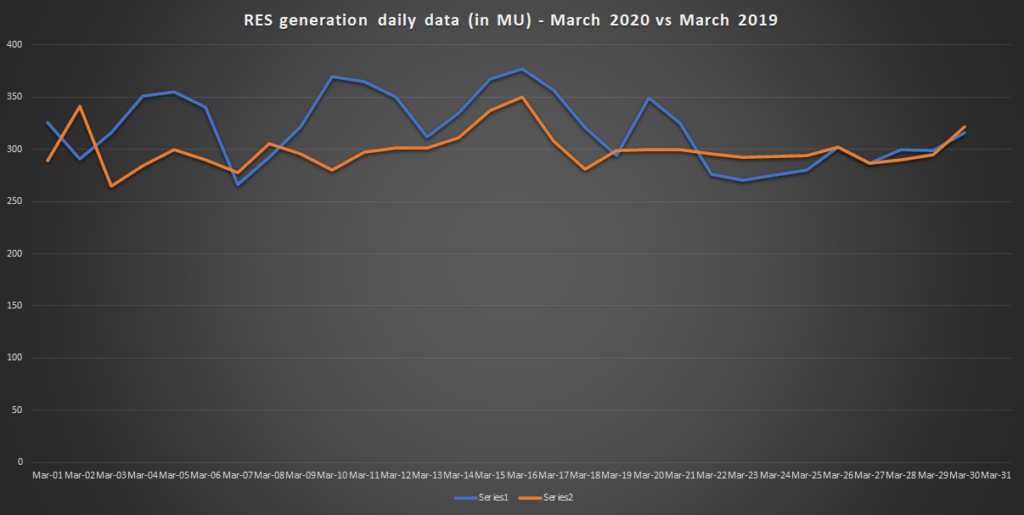India’s 3-week lockdown in response to the COVID 19 novel Coronavirus pandemic has resulted in a precipitous drop of 25-40% in peak energy demand over the past week when compared to corresponding dates from the previous year. Total power generation in the country has also declined around 25% over the past 10 days, and by over 30% compared to this time last year, according to the national grid operator Power System Operation Corporation Limited (POSOCO). Surprisingly though, after reaching a low of 108,906 MW on Friday, 27 March, demand picked up 2.7%, 1.8% and 5.5% respectively over 28, 29 and 30 March in an indication that adherence to the strict social distancing norms in the country may be slackening. The jump can mainly be attributed to the 12.75% increase seen in the Northern Region of the national grid.


The fall in demand has seen India rely heavily on non-fossil fuel sources of energy. India’s share of non-fossil fuel energy in its mix is currently between 27-29%, up by 7-10 percentage points since the third week of March when the share hovered around the 20% mark. The share of non-fossil energy sources is especially high in the Northern and Southern Regions which have registered non-fossil shares of above 40% in the last week. On 28 March, the share of non-fossil energy in the Northern Region was almost 47%! While nuclear power, used to maintain the national grid’s base load, has seen a jump of about 20-30% in generation, the share of renewables in the mix has also steadily increased to beyond 11% of the total.
While the heavy reliance on non-fossil energy sources and renewables has sparked fears of grid instability, the Indian government recently clarified that RE generating facilities are to be considered essential and ordered free-movement of goods and services required for the smooth functioning of RE power plants. With demand expected to take time to recover, and the likely delays in completion of thermal power plants (TPPs) and RE projects under-construction due to the disruption of global supply chains, there is a case to be made to meet all future increases in energy demand solely through renewables.

Even before the lockdown was effected, renewable energy generation in the country had already registered a 15-20% increase compared to last year which can be attributed to the almost 9GW of increased operational capacity that has been added in 2019-20 according to the Central Electricity Authority (CEA). The largest share of renewables has been registered in the Southern Region where around 20% of the current demand is being met through renewable sources. However, the increase has not been uniform across the country. While the Northern and Western Regions have recorded RE shares of close to 10%, the Eastern and North-Eastern Regions have registered abysmal figures close to 1% and 0% respectively.


The drop in India’s energy demand though has primarily translated to lesser generation from coal. Although power from coal had already dropped 5-10% in the weeks leading up to the lockdown, the past week has seen supply from thermal power plants decline by 35-40% compared to figures last year. The sluggish demand has seen India’s coal stocks breach 100 MT while stocks at power plants stand at close to 42 MT- enough for 24 days of consumption. The Centre has also sought to ease the burden on discoms during the COVID 19 pandemic by deferring payments of dues towards generating companies and transmission licensees by up to 3 months for both RE and TPP operators. While operators will hope for a swift return to normal, the trajectory of recovery may put a big question mark on the fate of around 62 GW worth of thermal power projects which are under construction, and around 30% of which is reliant on equipment and components from China.
About The Author
You may also like
Rise in Fossil Fuel Burning is Making Floods Lethal in Asia
Heatwaves Drove 9% of India’s Power Demand in the Summer of 2024
World Off-Track on Climate Goals as Temperatures are Predicted to Rise: Report
A Fifth of Migratory Species Face Extinction from Climate Change: Report
Climate change, unplanned construction and a malfunctioning dam can worsen the flooding in north Bengal

